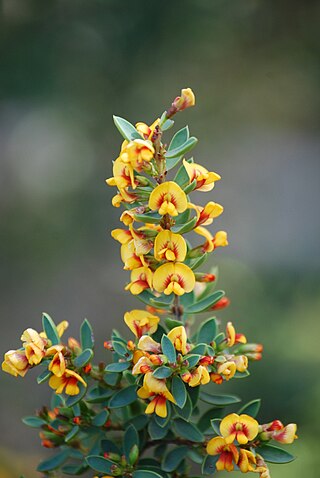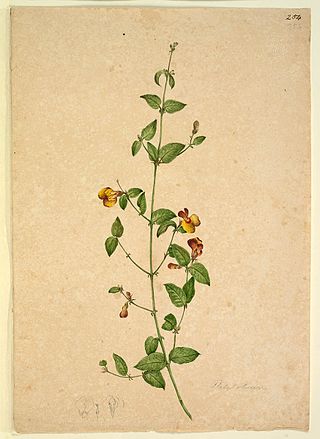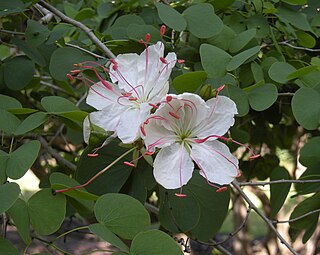
Cassia is a genus of flowering plants in the legume family, Fabaceae, and the subfamily Caesalpinioideae. Species are known commonly as cassias. The genus includes 37 species and has a pantropical distribution. Species of the genera Senna and Chamaecrista were previously included in Cassia. Cassia now generally includes the largest species of the legume subtribe Cassiinae, usually mid-sized to tall trees.
Almaleea is a genus of perennial shrubs from the family Fabaceae native to Australia.

Phyllota is a genus of flowering plants in the legume family, Fabaceae. It includes 11 species of shrubs native to temperate southeastern and southwestern Australia, in the states of New South Wales, Queensland, South Australia, Victoria, and Western Australia. They inhabit open woodland and forest, mallee woodland, and heathland, from coastal to semi-arid and montane areas.

Aotus is an Australian genus of flowering plants, within the legume family Fabaceae. Aotus species, together with other species of the tribe Mirbelieae, are often called golden peas because of their distinctive small yellow flowers. They are endemic to Australia, occurring in all states except the Northern Territory. Aotus are evergreen species. Some are widely cultivated by gardeners for their ornamental value.

Eutaxia is a genus of the family Fabaceae. They are native to Australia. Most are endemic to the Southwest Botanical Province of Western Australia, but a few are distributed throughout mainland Australia. The chromosome number of Eutaxia species is typically 2n = 14 or 16.

Dipteryx is a genus containing a number of species of large trees and possibly shrubs. It belongs to the "papilionoid" subfamily – Faboideae – of the family Fabaceae. This genus is native to South and Central America and the Caribbean. Formerly, the related genus Taralea was included in Dipteryx.

Templetonia is a genus of flowering plants in the family Fabaceae. They are native to Australia. The genus is named in honour of John Templeton, an Irish naturalist and botanist.

Gastrolobium is a genus of flowering plants in the family Fabaceae. There are over 100 species in this genus, and all but two are native to the south west region of Western Australia.

Platylobium is a genus of shrubs in the legume family, Fabaceae. Native to eastern and south eastern Australia, they occur in a range of habitats of the coastal regions. The genus was first described by James Edward Smith, and is closely allied to Bossiaea, another genus within the Mirbelioids.

Stackhousia is a genus of annual and perennial plants in the family Celastraceae that are native to Australia, New Zealand, Malesia and Micronesia. The genus was first described by James Edward Smith in Transactions of the Linnean Society of London in 1798.

Isotropis is a genus of flowering plants in the family Fabaceae. The genus is endemic to Australia.

Barklya is a genus of Australian trees in the legume family, Fabaceae. It belongs to the subfamily Cercidoideae. The sole species is Barklya syringifolia, commonly known as golden crown or golden glory. It grows in rainforest to 20 metres tall, and occurs in Queensland and New South Wales. It is often used as an ornamental.

Lysiphyllum is a genus of flowering plants in the legume family, Fabaceae. It includes nine species of trees, semi-scandent shrubs, and lianas which range from India through Southeast Asia to Australasia. Typical habitats include seasonally-dry tropical forest and woodland, vine thickets, Brigalow and Gidgee scrubland, floodplains, alluvial flats, tidal forest, mangroves, river and stream banks, and occasionally dunes and coral islets. They can grow on diverse soils including calcareous, granitic, and basaltic.

Aenictophyton is a genus of flowering plants in the legume family, Fabaceae. It belongs to the subfamily Faboideae. It contains two species which are endemic to Australia.

Euchilopsis linearis is a species of flowering plant in the family Fabaceae. It belongs to the subfamily Faboideae. It is the only member of the genus Euchilopsis. It is a shrub endemic to Southwest Australia.
Latrobea is a genus of flowering plants in the legume family, Fabaceae. It includes eight species of shrubs endemic to Southwest Australia. Typical habitats include forest, woodland, and heathland on sandy soils and swampy areas in higher-rainfall areas of the far southwest. The genus belongs to the subfamily Faboideae. The plant is named after Charles Joseph La Trobe.

Muelleranthus is a genus of flowering plants in the legume family, Fabaceae. It includes four species of herbs and shrubs native to Australia. Habitats include subtropical, mediterranean, and temperate climate shrubland, mostly on sandy soils in the central arid and semi-arid Eremaean region of the continent. It is often associated with Triodia tussock grasses. It belongs to the subfamily Faboideae.

Plagiocarpus is a genus of flowering plants in the legume family, Fabaceae. It includes seven species of shrubs or subshrubs native to northern Australia, from the Kimberley region of Western Australia to western Queensland. Their habitats include seasonally-dry tropical to subtropical woodland, bushland and thicket, shrubland, and grassland, typically on sandstone or sandy soils. It belongs to the subfamily Faboideae.

Smithia is a genus of flowering plants in the legume family, Fabaceae. It includes 20 species of herbs or subshrubs native to sub-Saharan Africa, the Indian subcontinent, Indochina, southern China, Japan, Malesia, and northern Australia. The greatest diversity of species is in the Indian subcontinent, with 11 endemic species. Six more are widespread in southern and eastern Asia, and two of these, S. conferta and S. sensitiva, range further to northern Australia. Two species are endemic to sub-Saharan Africa. S. elliotii is native to Madagascar as well as mainland Africa, and S. conferta is also native to Madagascar. Typical habitats include seasonally-dry tropical grassland, wetlands, and streamsides.
Stonesiella selaginoides, the clubmoss bush-pea, is a species of flowering plant in the family Fabaceae. It belongs to the subfamily Faboideae. It is the only member of the genus Stonesiella and is endemic to Tasmania. It is named to recognise Australian botanical illustrator Margaret Stones.

















